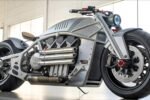Join on WhatsApp
Get the latest updates directly on WhatsApp – motivation, news & more!
When it comes to motorcycles, BMW has always been synonymous with innovation, quality, and a certain level of sophistication. Over the decades, BMW has produced some iconic motorcycles, each leaving a distinct mark on the industry. One such model that often comes up in conversations among motorcycle enthusiasts is the BMW R20. Though not as widely known as some of its siblings, the R20 holds a special place in BMW’s motorcycle history, especially for those who appreciate classic bikes and timeless engineering.
The History Behind the BMW R20
The BMW R20 was introduced in the early 1950s, a period marked by post-war recovery and innovation in the automotive world. BMW, rebuilding itself after World War II, aimed to produce motorcycles that were reliable, durable, and practical for everyday use. The R20 was part of this vision — a lightweight motorcycle designed for both city commuting and light touring.
It featured a 200cc single-cylinder engine, which was quite modest by today’s standards but was efficient and sufficient at the time. The R20 was BMW’s answer to the growing demand for affordable and economical motorcycles that could handle the increasing needs of post-war society.
Design and Engineering
One of the most striking features of the BMW R20 is its design simplicity paired with solid engineering. The bike had a minimalistic yet elegant look, reflecting BMW’s design philosophy of function meeting form. The frame was tubular steel, providing a strong backbone without adding unnecessary weight.
The single-cylinder engine was air-cooled, with a four-stroke design that gave the bike a smooth and steady power delivery. While it only produced around 8 horsepower, it was enough to cruise comfortably on city roads and even manage light country rides. The bike came with a four-speed gearbox, which was advanced for its time and allowed riders to enjoy a versatile riding experience.
Suspension on the R20 was basic by modern standards, with telescopic front forks and a plunger-style rear suspension. Though not designed for rough off-road terrain, it offered sufficient comfort for daily commuting and casual rides.
Riding Experience
Riding the BMW R20 today is like taking a trip back in time. The bike’s lightweight nature and manageable power make it ideal for beginner riders or those who want to enjoy a relaxed, nostalgic ride. It doesn’t offer the aggressive acceleration or high speeds of modern motorcycles, but what it lacks in power it makes up for in charm and character.
The upright riding position ensures comfort over longer rides, and the bike’s simplicity means maintenance is straightforward. For vintage motorcycle lovers, the R20 offers an authentic experience, with the mechanical hum of the single-cylinder engine creating a unique soundtrack on the road.
Why the BMW R20 Still Matters
Even decades after its release, the BMW R20 holds relevance among classic motorcycle collectors and enthusiasts. Its value is not just in the mechanics or performance but in what it represents — a time when motorcycles were simpler, more accessible, and built with longevity in mind.
The R20 is often appreciated as a collectible item, symbolizing the resilience and ingenuity of BMW in the post-war era. Restoring and owning an R20 is a hobby for many vintage bike lovers who admire the craftsmanship and historical significance embedded in every part of the motorcycle.
Moreover, the R20 serves as a reminder of how far motorcycle technology has come. By comparing it to contemporary models, riders gain a deeper appreciation for advancements in engineering, safety, and comfort.
BMW’s Legacy in Motorcycle Manufacturing
The BMW R20 is just one chapter in the larger story of BMW’s motorcycle legacy. From early singles like the R20 to the iconic boxer twins and powerful sport bikes of today, BMW has continually evolved while maintaining a commitment to quality.
BMW motorcycles are known for their innovative technologies such as shaft drives, advanced suspension systems, and electronic rider aids. The R20 laid the groundwork for this by proving that reliability and practicality could be combined with engineering excellence.
This legacy continues to influence motorcycle design and culture globally. Riders who cherish performance and engineering excellence often look to BMW as a benchmark, and classic models like the R20 are the roots of that reputation.
Collecting and Restoring the BMW R20
For enthusiasts interested in classic motorcycles, the BMW R20 offers an exciting project. Due to its relative rarity and age, finding an original R20 in good condition can be challenging, but many restorers take pride in bringing these vintage machines back to life.
Restoring an R20 involves sourcing original parts, understanding the unique mechanical setup, and paying attention to details like paint schemes and logos to preserve authenticity. The reward is not just a functioning motorcycle but a piece of history that tells a story every time it’s taken out on the road.
Joining classic motorcycle clubs and forums can be invaluable for those working on an R20, providing access to expert advice, parts suppliers, and a community of like-minded riders.
Conclusion
The BMW R20 may not be the fastest or most powerful motorcycle, but it is a significant piece of motorcycling history. It stands as a testament to BMW’s resilience and dedication to quality during a transformative era. For those who appreciate classic motorcycles, the R20 offers a unique blend of simplicity, charm, and historical importance.
Whether admired as a collector’s item, enjoyed as a weekend ride, or studied as a milestone in motorcycle engineering, the BMW R20 continues to capture the imagination of riders and enthusiasts around the world. It reminds us that sometimes, the most enduring machines are not those that push the limits of speed but those that embody timeless design and craftsmanship.




